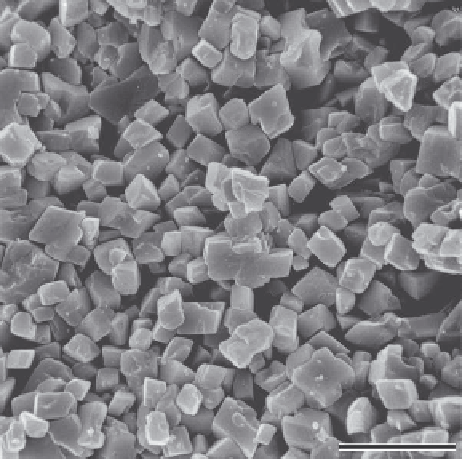Geology Reference
In-Depth Information
(readily seen in grainstones), and produces compressed
fabrics (Sect. 7.5.1).
•
Chemical compaction:
Starts at various depths of
overburden (commonly several hundreds and thousands
of meters, but also at an overburden of 100 or 200 m).
Reduces thickness of sediments, porosity, and perme-
ability. Produces stylolites and other pressure-solution
structures. Pressure solution provides carbonate for
burial cementation (Sect. 7.5.2).
•
Cementation:
Produces coarse calcite spar cements.
The cements are enriched in iron and manganese, poor
in strontium. Fluid inclusions are common. Coarse or
poikilotopic calcite, drusy and other calcite mosaics,
saddle dolomite.
•
Minor solution porosity:
Caused by dissolution of
carbonate and calcium sulphate minerals.
•
Burial dolomitization:
Anhedral crystalline fabric;
generally coarse crystals.
Fig. 7.4.
Microporosity in a micritic reservoir rock.
Porosity
is caused by equant to equant-elongate or tubular or platy
pores between calcite crystals (intercrystalline porosity). In
this sample pores are very small (0.5 to 5
m, mostly < 3
m),
but effective porosity is high because of well-developed pore
throats and good permeability. The rhombohedral crystals are
of different size and have well-developed crystal faces, form-
ing an inequigranular idiotopic crystal fabric sensu Friedman
(1965). Microporosity occurs in the matrix of lime mudstones,
wackestones and packstones as well as in carbonate grains.
Processes involved in the creation of microporosity are dis-
solution, dolomitization and incipient weathering. SEM. Sub-
surface. Late Cretaceous: Ras Al Kaimah, United Arabian
Emirates. Scale is 10
m.
7.2.2 Early and Late Diagenesis
Diagenesis continues throughout the life of a sediment
or sedimentary rock. No clear boundary can be placed
within the continuum of diagenetic alterations that
change carbonate sediments to carbonate rocks, but the
terms early and late diagenesis are generally used in
order to indicate the relative timing of diagenetic pro-
cesses. The term
early diagenesis
refers to diagenesis
occurring immediately after deposition or immediately
after burial (Berner 1980). Reviews of early diagen-
esis were written by Bathurst (1989) and Dickson
(1984).
Late diagenesis
occurs a long time after depo-
sition, when the sediment is already more or less com-
pacted into a rock and corresponds to burial processes
acting in the subsurface over a long geological time.
The relative importance of early diagenesis versus
late burial diagenesis is controversial (Longman 1980,
Scholle and Halley 1985), but most carbonate rocks
appear to be more intensively affected by burial than
by early diagenetic processes.
tively differentiated, and the relationships of thin-sec-
tion porosity and porosimetry data to be discussed.
The following text concentrates on the basic termi-
nology and the practical pore type classification in thin
sections.
7.3.1 Porosity Categories, Pore Geometry
and Permeability
7.3.1.1 Basic Definitions
7.3 Porosity of Carbonate Rocks
Porosity is the percentage of the bulk volume of a
rock that is occupied by interstices, whether isolated or
connected. This definition describes the
total porosity
which must be separated from the
effective porosity
.
The latter is the percentage of the total rock volume
that consists of interconnected pores. Many carbonate
rocks no longer exhibit open pores, but
former inter-
stices
which have been filled with cement.
An estima-
tion of this
minus
-
cement porosity
, representing the sum
Porosity is a prerequisite for the course of diagenesis.
Porosity studies of carbonate rocks are crucial in un-
derstanding diagenetic processes and highly significant
in evaluating reservoir rocks (Wardlaw 1979; Ehrlich
et al. 1991; Chilingarian et al. 1992; Moore 2001; see
Sect. 17.1.3.1).
Thin sections of limestones and dolomites allow di-
agenetic pore types to be qualitatively and quantita-

